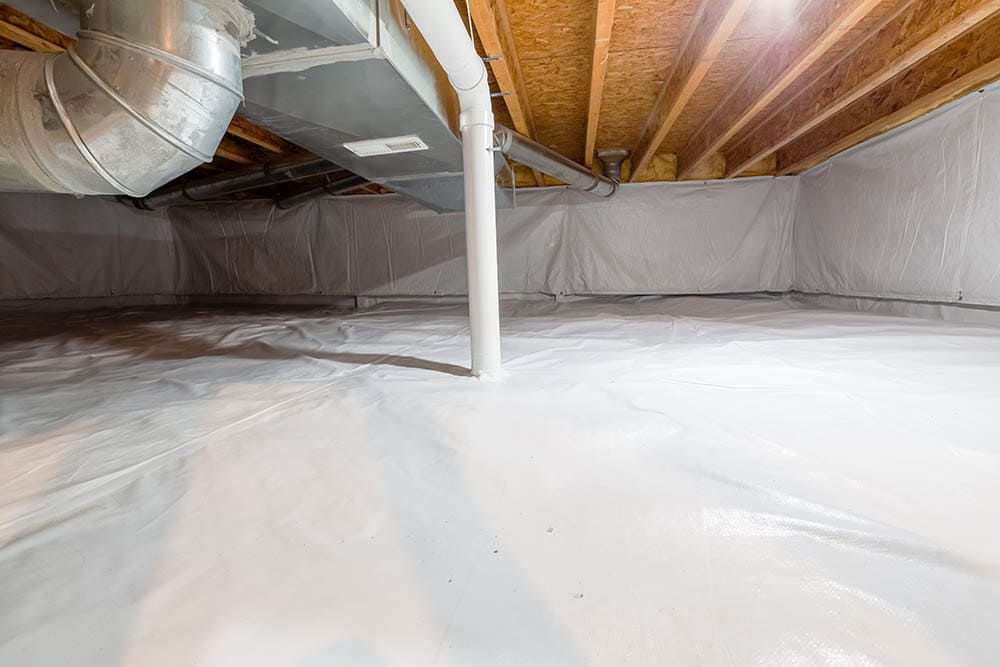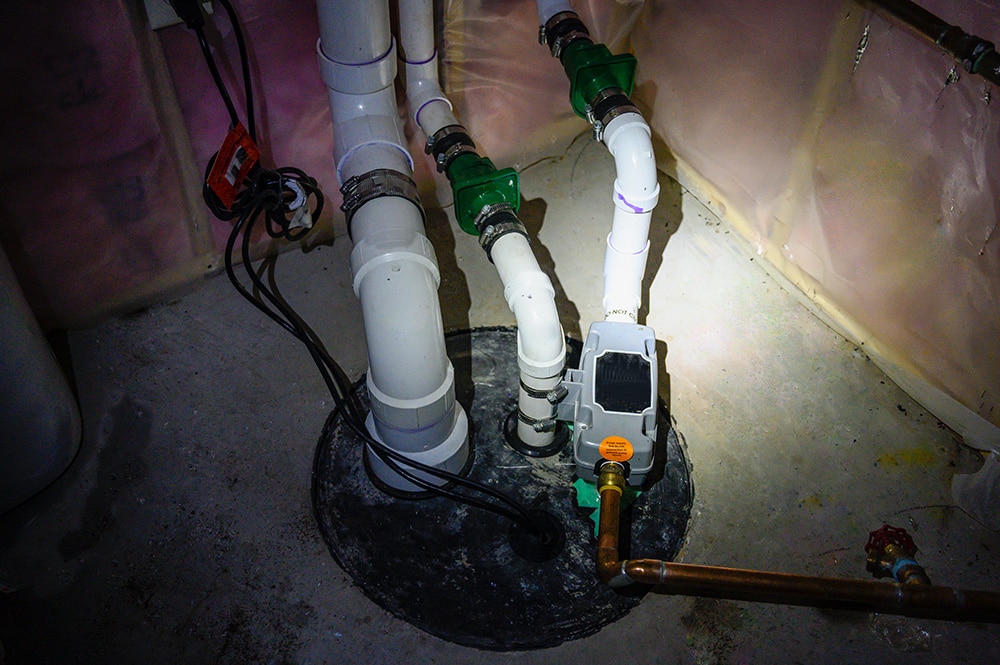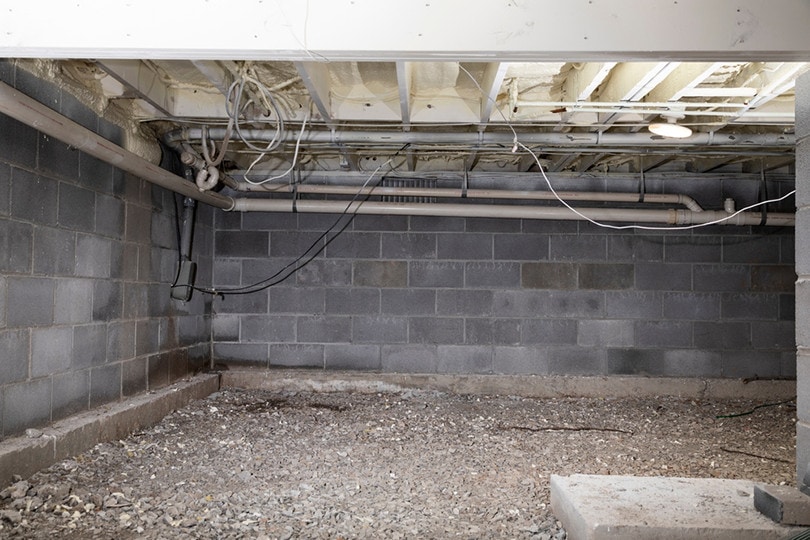What is the Ideal Humidity Level for a Crawl Space?
-
- Last updated:

Crawl spaces can be damp and dank because of outdoor temperature and humidity variations. Even if you have perfect plumbing and no flooding issues, your crawl space can still be plagued with a moisture problem because of outdoor air entering the space through the vents or moisture evaporating from the ground.
It is crucial to constantly monitor the humidity levels in this low-lying area to protect your home’s air quality. Because of the “stack effect1,” hot air from the crawl space and basement rises to your living areas and attic. Keeping the relative humidity levels between 45% and 55% can help prevent pest infestations and musty odors from mold and mildew affecting the rest of your home.
Let’s look at the ideal humidity level for a crawl space. We will also discuss how to keep humidity levels in check and avoid potential health and structural problems.

Normal Crawl Space Humidity Levels
Relative humidity is the standard measurement for water in the air relative to the maximum amount of water that air can hold. If your crawl space has 60% humidity, the air is holding 60% water.
Air enters your home through the lower levels and exits through the upper levels. When the air pulled into your crawl space from outside is warmer, it instantly cools to match the air temperatures in this cool, underground space.
Condensation occurs if the relative humidity is too high to hold more water. When the humidity reaches 100%, the air cannot hold more water. It will drop the excess humidity as condensation causes problems like mold, mildew, and wood rot.
The temperature of outdoor air getting pulled into your crawl space varies depending on the season. Generally, the differences between outdoor and crawl space air temperatures cause condensation when the two types of air collide.

Humidity Levels in Winter
The stack effect intensifies during the winter months. The frozen soil will make your crawl space chiller, and this air will rise to your living spaces. You will likely heat your home constantly to maintain comfortable temperatures, worsening the problem. When warm air from your heated living spaces collides with cold air from the basement, you will deal with condensation.
Humidity Levels in Spring
The promise of warmer weather in spring is not as exciting if you have moisture problems in your crawl space. As the temperatures rise, so will the humidity levels. The warmer air entering your crawl space will increase the relative humidity causing condensation.
Humidity Levels in Summer
The warm air in summer has higher humidity, meaning it already contains a lot of water. Air entering your home through the lower levels can increase the relative humidity in your crawl space by a considerable percentage. If the relative humidity hits 100%, the air will have to give up its water in the form of condensation.
Humidity Levels in Fall
There’s less sunlight in the fall, meaning the season brings cooler temperatures. You will likely switch from using your air conditioning to using your furnaces and space heaters. Even though the temperatures are temperate in fall, heating the air in your living spaces will cause condensation in lower-level structures like your crawl space.

What Is the Ideal Crawl Space Humidity?
The ideal crawl space humidity should be mid-range. Humidity between 45% and 55% should ensure comfort without causing common problems associated with extremely high or low humidity.
Low humidity makes the skin dry and causes throat and sinus irritations. On the other hand, high humidity increases the risk of condensation and encourages the growth of mold and other harmful bacteria that can lead to respiratory issues and allergies.
The general rule is that if your crawl space is moldy and musty, so will the rest of your house. To be safe, you need long-term solutions like investing in a dehumidifier. Adjust it in tune with the changes in the external relative humidity based on the season.
How to Remove Excess Humidity from Your Crawl Space
A humidity problem in your crawl space is bad news for your comfort, health, and home’s structural integrity. Here are four ways to help you maintain the ideal humidity levels in your crawl space.

1. Seal Cracks and Gaps
First, you should seal your crawl space to ensure outdoor air is not pulled into the area through cracks and gaps. Sealing unwanted openings will also block out groundwater, preventing it from entering the area. Be sure to inspect your plumbing for leaks and address any issues of concern.
2. Encapsulate Your Crawl Space
Encapsulating a crawl space involves installing a thick plastic sheet covering the floor and walls. The plastic serves as a vapor barrier that helps to keep your insulation dry by locking out moisture from the ground. Because the 20-mil vapor barrier system is puncture-proof and has a mold-resistant additive, your crawl space will remain dry and mold-free.
3. Install a Sump Pump
A sump pump is a device submersed in a pit dug at the lowest point of your house, like your crawl space. Any water in your crawl space will drain into a discharge pipe and be directed away from your home’s foundation.
If you opt for a sump pump, ensure it has the appropriate horsepower, especially if your crawl space is prone to flooding. Also, inspect it regularly and seek repairs or replacements whenever necessary.

4. Install a Dehumidifier
Another ideal solution is to invest in a dehumidifier. The device will help you monitor humidity levels in your crawl space. Of course, you can adjust the settings to maintain optimal relative humidity levels. Dehumidifiers are automatic appliances that turn on and dry out the air when they detect a moisture spike and turn off when the moisture level drops.
So, do you need a dehumidifier if your crawl space is encapsulated?
Yes. Even with encapsulation, your crawl space air quality will still depend on the climate. Once you block ground moisture evaporation, the area can still have moisture buildup because of high outdoor humidity, duct-work condensation, and more. A dehumidifier makes it easier to regulate humidity from various sources.

Dehumidifier vs Air Conditioner for Crawl Space: Which Is Better?
You can maintain a healthy crawl space by keeping humidity as low as possible through all seasons. If the humidity cannot go below the recommended 55% maximum, you can address the concern by turning on an AC to keep the air moving. Both dehumidifiers and air conditioners can help remove excess humidity from the air.
However, a dehumidifier can reduce humidity but will not alter the temperatures in your crawl space. An AC, on the other hand, can lower the temperature significantly and reduce humidity. With an AC, the volume of moisture removed is not as substantial.
Crawl spaces are typically cooler than upper-level spaces, making cooling them further unnecessary. If your primary aim is to regulate humidity levels, encapsulating your crawl space and installing a dehumidifier will offer a more efficient and long-lasting solution.


FAQs
Moisture problems in the crawl space are quite common but often misunderstood. Here is more information to help you maintain optimal humidity in your crawl space.
What Are the Signs of High Humidity In the Crawl Space?
A spike in the humidity levels in your crawl space can quickly spread mold and dust mites to the upper floors. You can tell that your crawl space has a humidity problem if you notice the musty odor of mold and mildew. Other common signs include standing water on the floor or water droplets on the walls.
How Frequently Should I Run a Dehumidifier In My Crawl Space?
It is best to run your dehumidifier for at least 12 hours daily to ensure the air in the living space remains clean and fresh. Because the ideal schedule can change based on season, make sure you adjust the settings on the device, allowing it to kick in when it senses an increase in moisture levels.
What Happens If the Humidity In My Crawl Space Is Too Low?
A drastic drop in the humidity levels in your crawl space can cause health problems and impact the structural integrity of your property. For instance, it can lead to a decrease in wood moisture content, causing lumber shrinkage. You may begin noticing gaps between your hardwood flooring or between the trim joints.

Final Words
Outdoor humidity is always fluctuating, irrespective of where you live. With hot, humid summers and cold, dry winters, your crawl space can take a major hit and leave you battling never-ending mold, pest, and wood rot issues. Damp, humid crawl spaces can cause havoc in your home and become a potential source of embarrassment when you host guests.
We hope you are now well-acquainted with various methods to keep this low-lying area dry and moisture-free through different seasons.
Featured Image Credit: grandbrothers, Shutterstock
Contents

